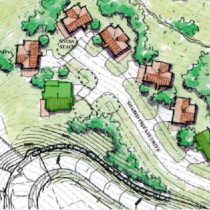Landscape Architecture for Landscape Architects › Forums › PROFESSIONAL PRACTICE › Is CLARB’s redline review really worth it?
- This topic has 1 reply, 26 voices, and was last updated 11 years, 7 months ago by
 jeffrey Gordon Smith.
jeffrey Gordon Smith.
-
AuthorPosts
-
September 3, 2010 at 7:07 pm #167990
Ed Dermody
ParticipantAfter reading this discussion, it seems to be heading into ‘why I do not like CLARB and LARE.” I want to state, that as a licensed LA, CLARB member and sole practitioner. I enjoy and appreciate CLARB. They work very tirelessly through paid staff and volunteers to insure that LARE process is fair. What many of fail to recognize is that the exam is about public health, safety and well fair and establishing the minimum standards for that.
Thank about it –if you do not understand the fundamentals of our profession and the art of design and developing construction documents, then you will cause issues in time. Those issues will cost time; money and God forbid threaten someone’s health, safety and well fair.
That said:
• Respond to the exam questions, as they ask, no more, no less.
• Take the Redline Review (if you do not like the cost, then don’t –that’s up to you)
• Act like a professional and begin to educate others about your chosen profession and stop being negative on what you do not understand. This is our profession, act like it.
• If you continue to fail, try asking your university for refund. They may not have given you the tools necessary to succeed. (There are many programs in the country that do not teach LA’s how to develop proper construction documents)AND LAST: This level of self loathing and criticism does little for you, me or our profession. If you do not like the process, then get out now or begin to act with respect to yourself, your peers and your profession. Can you image what your clients will think when read this rant?
September 4, 2010 at 12:28 am #167989 Andrew Garulay, RLAParticipant
Andrew Garulay, RLAParticipantTanya,
You are correct in what I meant.
I looked through an old notebook tonight and found the redline review trifold from back in the day “L.A.R.E. Review Procedures”. You had to be in a secure room with a monitor, no notes, no materials with you at all, maximum of one hour, and only one review per section (no other review in subsequent years).
The original graders did not mark up the solutions tests. They were graded two different times by two different graders independently. A master grader would inspect the solution if there were any discrepencies between the two independent graders. In thecase of a redline review, a different person would mark up a copy of the applicants test in very generic terms in order for you to identify your weakness rather than showing you the specific solution.
September 4, 2010 at 12:53 am #167988 Andrew Garulay, RLAParticipant
Andrew Garulay, RLAParticipantMost of us want to get licensed as soon as possible to be a member of the profession. I sure did. The perspective is one from our own sense of self worth as being a member of the profession working in the profession. We have to remember that the primary reason behind licensure is not about career advancement or joining a club. It is supposedly to determine whether applicants posses sufficient knowledge, skills and abilities to provide landscape architectural services without endangering the health, safety, and welfare of the public.
It is also important to realize that there is only one license. There are no advanced licenses, so once you have it you are fully licensed. It is not a license that means that you are minimally qualified to “work” as a landscape architect. Your employers and potential employers determine that. It is a license which says that you are minimally qualified to practice landscape architecture independently. I think we tend not to lose that perspective when we are starting out.
Another thing that we have to remember is that it does not mean that anyone believes that anyone is necessarily enndangering the health or welfare of the public because (s)he has not passed LARE. It is, however, believed that there is potential for endangerment for someone to practicie independently without having demonstrated this minimal standard of KSAs.
The best thing that you can do, in my opinion, is to get tutored by someone who has passed Section E and does a lot of grading and drainage in their day to day work.
September 4, 2010 at 1:57 am #167987Tanya Olson
ParticipantI hope it makes you feel better that two of the most original and creative landscape architectural designers I know failed and failed and failed. One is a highly respected practitioner and professor, another worked for one of the big three mid century LAs and was a partner in a firm for years before he could pass that state’s LARE. Another good friend had no formal LA training – just engineering training and passed no problem.
And Ed – they bitched about it plenty. Here are people who had worked for some of the leading firms in the country and couldn’t pass. The kicker for them it that it was reportedly section C (the design section) that messed them up! One of them boycotted the exam for a long time. I’m not sure that she ever took it.
My guess is that you will pass if you think more like an engineer than an LA.
September 4, 2010 at 4:47 am #167986 Jason T. RadiceParticipant
Jason T. RadiceParticipantI second the statement that most want the license as soon as they can get it. I waited a few years in practice and it was worth it. I doubt I could have passed if I took it right when I became eligible to. I made sure I knew exactly what the heck I was doing before I sat for the test, and made it through with no problems. Was it easy, no. I’ve suggested to my legislative comittee if ASLA that my state actually make the qualifications for licensure STIFFER. Wait another year or two before you can take the exam, it would certainly help the pass/fail rate and guarantee a higher quality applicant, you have to wait longer for the architecture exam, and the engineering exam (which is two separate exams).
September 4, 2010 at 1:40 pm #167985 Frank VarroParticipant
Frank VarroParticipantThe issue is, you shouldn’t HAVE to pay to make sure your test was graded correctly, or even to see what you did wrong. It should be all or nothing. Either no one gets to see the tests, or everyone does, for free.
No, life is not fair, but life shouldn’t be made unfair because the people giving the licensing test I need to take want to make cash more than they want to make a test that everyone has an equal shot at passing.
Sure, life isn’t fair in the career opportunities you get, or the contracts you get once you have a position at a firm. But the ability to practice being hinged partially on paying more for a test you already paid to take is ridiculous. Think of how many years of productive professional years are lost by people who take the test 3-4 times even though they should have passed the first time? An extra two years spent not thinking about design in downtime, just thinking about grading that they already know.
September 4, 2010 at 10:29 pm #167984 Andrew Garulay, RLAParticipant
Andrew Garulay, RLAParticipantIt is not about paying to make sure that it is graded fairly. It is initially graded independently by two graders who do not make any marks on the paper at all. Supposedly, they typically find the same errors. If they don’t, a “Master Grader” takes another shot at it to resolve what the correct grade is.
The red line review is an additional process that they came up with so that frustrated people (like me) could see their test with some very general comments on it. It does not show you the solution or give a detailed description of how it did not pass. It means digging out the test, having another person review it and the comments of the original graders, marking up a copy, shipping it to your state’s exam administrators, and reserving a secure room with one of the test administrators for security. That has some additional expense to it.
All you get out of it is very general comments like “the candidate does not understandcirculation safety, vehicular circulation conflicts with pedestrian circulation” (right out of a 1999 LARE Review Procedures pamphlet).
The information might be too vague to help you out, but in some cases such as mine between the notes and seeing my exact test in front of me it was clear as a bell.
I would not recommend a red line review unless you are pretty darn confident that you know the material but must be making some kind of drafting or other technical error that is knocking a lot of points of or dropping you through a trap door. There won’t be anything on it that will make you understand something that you don’t already know. There won’t be any opportunity to see if you are “graded fairly” or contest the grade.
It is really only a chance to see what you did without being under the pressure or fatigueof taking the test.
Everyone has an equal shot. It is the exact same test happening on the exact same days in 46 states and two provinces with people trained to grade these exact few tests, grading them independently, being checked to see that both graders had the same result, …. what the heck else are they supposed to do?
September 6, 2010 at 1:25 pm #167983 Linda McDougallParticipant
Linda McDougallParticipantClass Action?
September 6, 2010 at 1:32 pm #167982 Linda McDougallParticipant
Linda McDougallParticipantclass action ?
September 16, 2010 at 3:24 am #167981 Drew SivgalsParticipant
Drew SivgalsParticipantI must agree with Jeffery. The test is just mentally and spiritually frustrating. It is nothing more than a bureaucratic hoop jumping experience. By no means does it truly test ones ability as a Landscape Architect. It is not based upon real world experience or typical process. In particular, the Grading and Drainage Section is almost comical. After discovering I failed the section, I paid the money to see the red-line(s) (why I failed), and no exaggeration, but I failed because I drew a pathway that approximately 98 – 99 feet away from the lake, when the setback was 100 feet. That’s it… Yes it was incorrect, but the scale of the drawing was 1″ = 100′, so we are talking about the width of the pencil lead. If that was a ‘real-life’ project, the City or County would have made me make the proper corrections and resubmit. They would not take my license away.
Oh, while on the subject of the Grading Exam, I love the ‘roof run-off and pipe sizing’ calculation problems… as far as my experience, that issue falls under the scope of a Civil Engineer (in California), not a Landscape Architect.
And the Examine sure does not test ones ability to Design… in any true capacity. Unfortunately, because one is licensed, it surely does not mean they produce good, creative. and problem solving design work. The bottom line is that the examine has one of the highest failure rates (particularly the graphic problems) of any profession. Even the Bar Examine passes far more percentage wise…
The strange thing about the exam is that it is not really difficult. It is more of a test of following exact directions under time constraint. I agree with others who say that perhaps they should make the exam more difficult, as long as it is based in reality. I don’t know about other states, but California’s exam certainly is not.
September 16, 2010 at 11:49 am #167980 Andrew Garulay, RLAParticipant
Andrew Garulay, RLAParticipantYour redline review sounds similar to mine. I did not make the same mistake again and I doubt if you did either. These are the people who benefit from the redline review.
I don’t know what anyone expects a licensure exam to be other than something similar to what it is. You can’t quantifiably measure “creativity” and frankly it is not what licensure is about.
There are countless posts on countless threads on countless messageboards complaining that engineers are doing work that should rightfully be ours because we are much better prepared to do eerything that is not buildings and then just as many that don’t believe we should be tested on these technical issues.
I said it before, like it or not, LARE defines landscape architecture as a profession. Whatever that test covers is what you have to know to be one. Whoever has the license should then be recognized by prospective employers or clients of having AT LEAST these particular abilities. What do we have to hang our hats on in a very competitive market if we are only tested on qualitative design problems?
The test is not rocket science. It is in itself a problem solving exercise. We have a profession that blends right brain and left brain processes. It is a profession that is most attractive to very right brained dominant people, many of whom struggle with left brain activity. The strength of our profession, as it is defined (by LARE) is that blend of left and right brain. Very few people are wired with a strong ability in both left and right brained abilities.
You have left brained professions such as architecture and engineering. You have right brained landscape and garden designers who leave the technical to the engineers. We either become just other landscape and garden designers in the market who pay for a lot of school for a rubber stamp, or we have to have documentation of a greater ability through that rubber stamp.
September 16, 2010 at 12:39 pm #167979Pat S. Rosend
ParticipantAs an FYI, we did a study of license exams a few years ago in my office and it turns out the PE exam is all multiple choice. No drawing. It probably explains why engineers can’t grade 🙂
September 16, 2010 at 1:17 pm #167978 Elizabeth RentonParticipant
Elizabeth RentonParticipantI’m interested in what else you discovered during your study of the various licensing exams. Do tell!
September 17, 2010 at 3:32 am #167977 earthworkerParticipant
earthworkerParticipantThe test is not about ‘aesthetic’ design which I assume any designer would have some skill with. The test is determining your ability to follow rules and maintain minimum life, safety, welfare standards. If you want the word ‘architect’ in your landscape architect job title, you are going to have to earn it. Like it or not, errors in our designs can seriously injur the the public and cost clients and municipalities millions of dollars. As a landscape ARCHITECT we must know all factors of a project as they pertain to not only aesthetic design but constructability and safety as well.
We are generalists. We must know a little about a lot. The test encompasses that. Sure it’s frustrating. It should be…..The public deserves to know that their environments are designed by qualified individuals. As a licensed professional, we must know about grading, we must know about watersheds, we must know how buildings and their associated infrastructures are built.
The test is merely a minimal standard measure of these elements we MUST know to call ourselves landscape ARCHITECTS……Oh, and a two foot mistake that is not caught by the part time plan reviewer at the city will be approved and then get sent to the contractor, passed on to the surveyor for staking, built in the field and cost your client $10,000 to remedy once the Army Corps realizes you’ve crossed into a wetland.September 30, 2010 at 2:18 pm #167976 Denise Y. O’Meara, ASLA, LEED APParticipant
Denise Y. O’Meara, ASLA, LEED APParticipantThanks for that reply, Landplanner.
I don’t think many LA’s realize, either because of their newness to the field or because of the area of practice that they are in, that the engineering-related aspects of our practice, such as stormwater calculations, are an integral part of landscape design, in fact of sustainable design. At the University of Kentucky we were taught grading, drainage, road alignment, in-depth construction techniques and other nuts and bolts elements of design as well as design theory/practice and planning – because you can’t do one without the other. I know that some LA programs do not include these elements, and it is not easy to learn those basics via OJT, unless you can find a civil engineering firm with endless patience to hire you.
I would say this, (though my professors would laugh, as I was once a deer in the headlights too): the more scientific education you have to back up your design, the more likely it is that you will perform your services for the public without compromising their safety or putting your constructed elements in danger of failure. Beautiful, aesthetic and useful design has a framework of elegant pieces and parts, much like the body of a human. You must understand its components, how it’s put together and it’s spiritual and aesthetic wholeness to create harmony and sustainability in the landscape.
More pointedly, if you want to be respected as a professional on par with architects and engineers, and this will affect your bottom line, you need to aim high in your competency to serve your client well.
-
AuthorPosts
- You must be logged in to reply to this topic.

